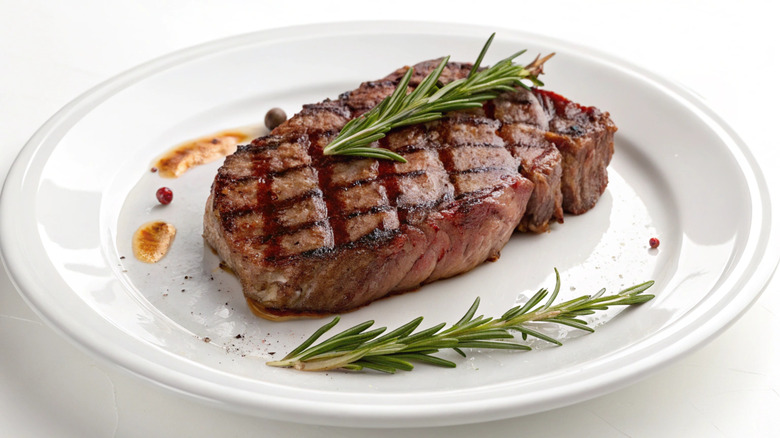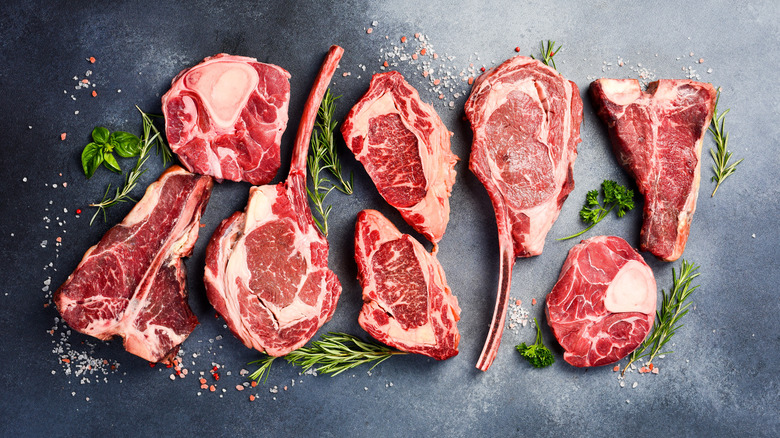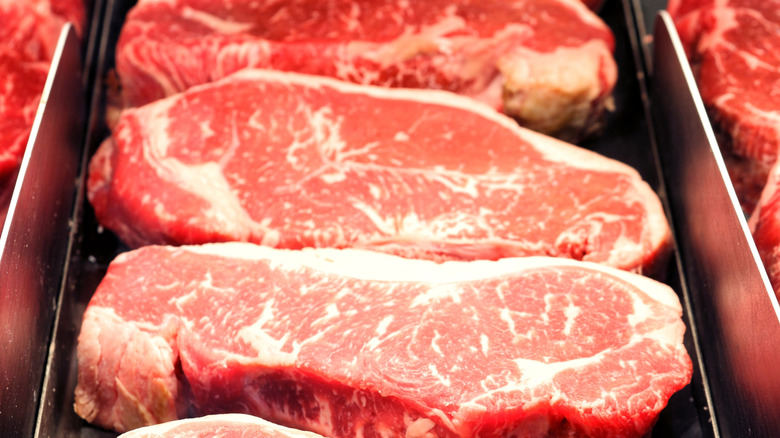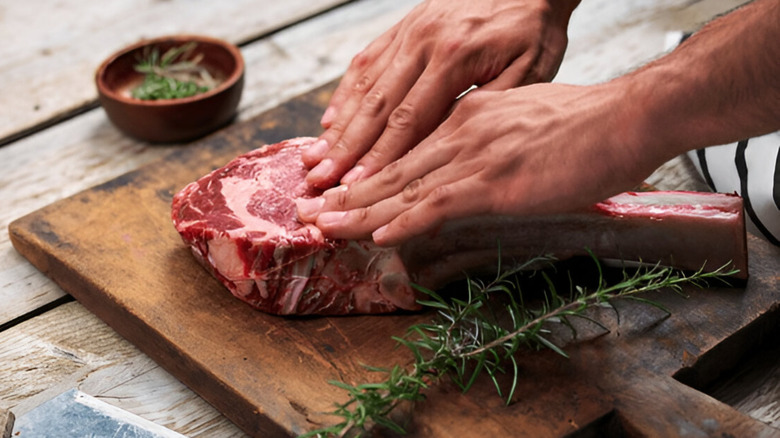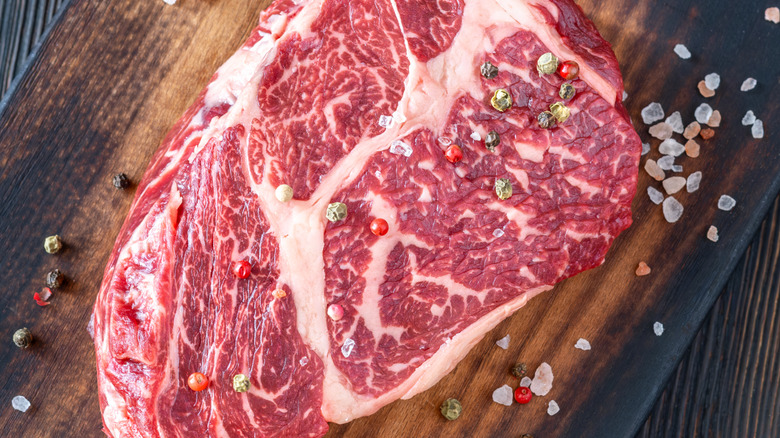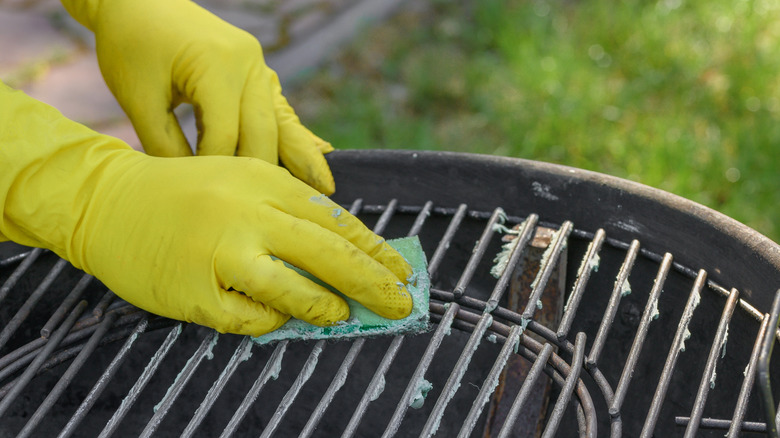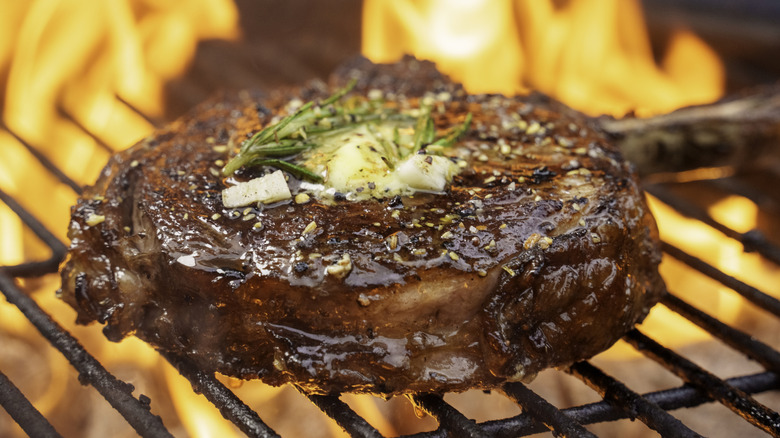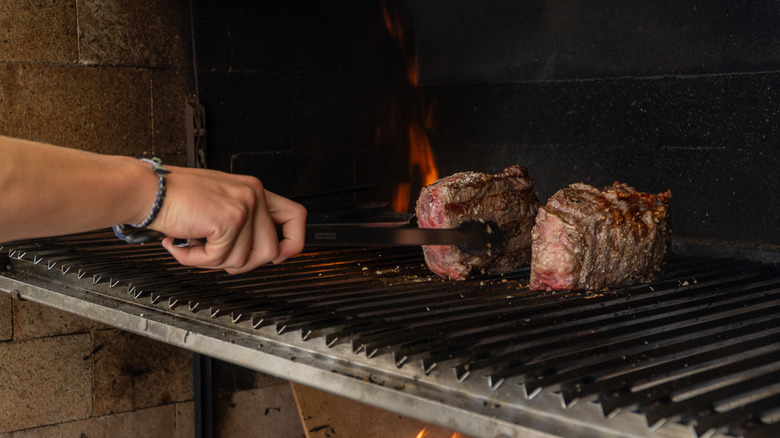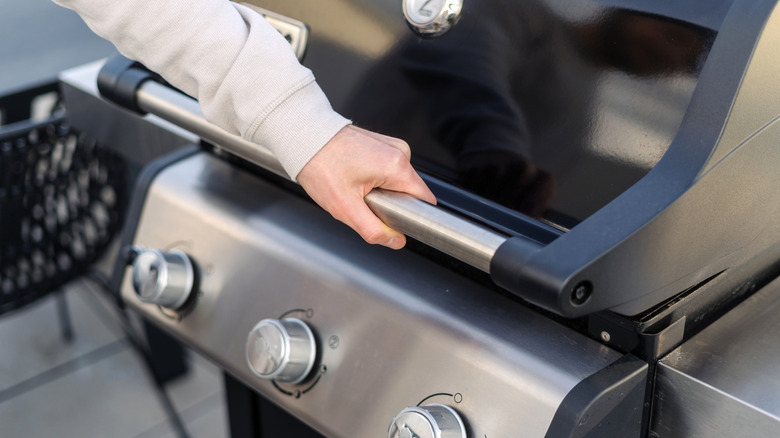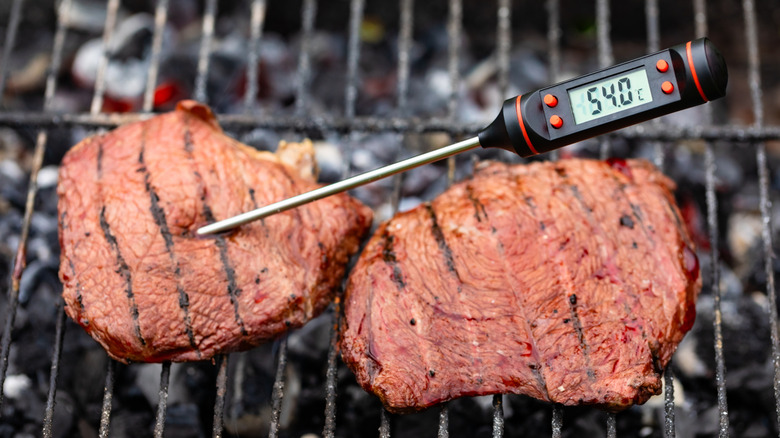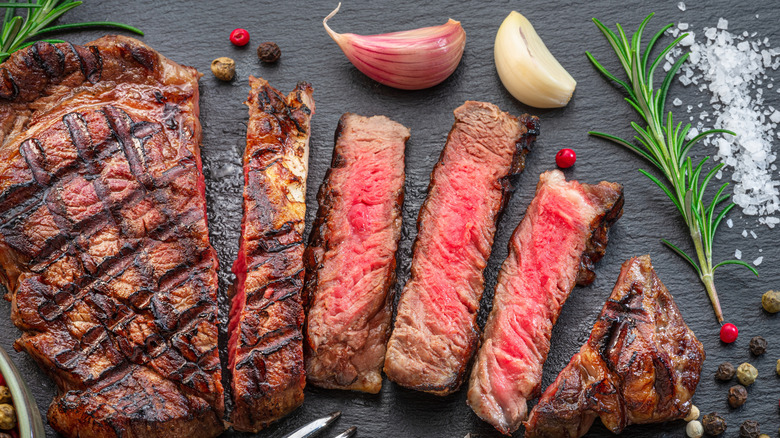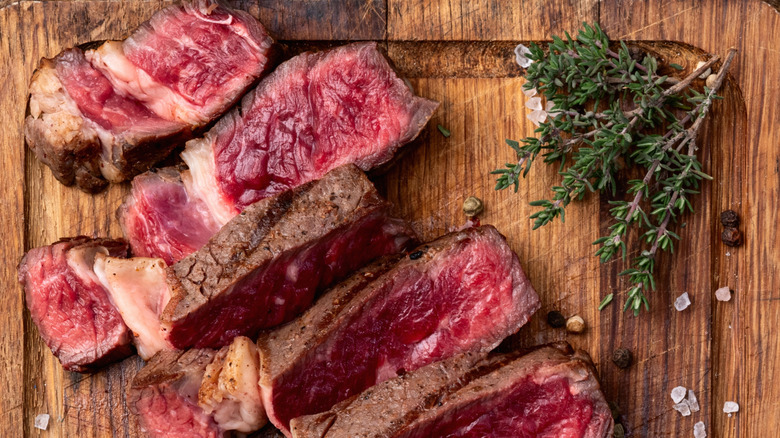The Biggest Cooking Mistakes That Ruin A Perfect Ribeye Steak
Carnivores and grill aficionados unite when steak is on the menu. For many of us, steak can mark a special occasion, making the choice of cut even more important. Those who love a flavorful, juicy steak dinner can look no further than the ribeye. Ribeye steaks are cut from the rib section of a steer, which makes the meat naturally tender due to its high fat content. Ribeye is also loved for its buttery, beefy taste, similar to the prime rib that you may have for those extra special holiday occasions. A ribeye is a premium cut of meat that can be bone-in (like a thick, massive tomahawk steak) or boneless.
If you want the ribeye and are thinking you need a reason to justify it, we have good news for you. You can forego the big restaurant price tag, and you can make a ribeye right at home that can rival your favorite steakhouse. However, some big cooking mistakes can leave your ribeye in ruins, so read on to find out what to avoid when preparing your steak.
Selecting too lean of a cut
When you are at your local butcher or grocery store staring at all the steak options, you may think that all the steaks will taste the same. But despite coming from the same animal, each cut of beef can vary in taste. When selecting your ribeye to cook at home, you'll want to look for a steak with lots of marbling. The well-distributed fat is what makes this cut of meat so delicious (and popular).
During cooking, the fat will render and impart lots of flavor while crisping up the exterior. Even if you are avoiding fatty meat for health concerns, you may be disappointed to find that a leaner ribeye cut just doesn't taste as good.
A thicker cut also helps you to avoid overcooking the steak on the grill, which can happen with thinner cuts of meat. "A thick cut allows for control and for the fire to infuse more flavor. It also gives a little room for error," Joy Beber, Executive Chef and co-owner of Joy Cafe in Atlanta, told Mashed. So you can rest assured that the likelihood of your steak getting overcooked is a bit slimmer if you opt for that super marbled ribeye.
Cooking the steak cold
So you have selected your perfectly marbled ribeye, brought it home, and placed it in your fridge. You may be excited to grill your steak right away, but be patient. Taking your ribeye right from the fridge to the grill or pan can be a big mistake. Putting your cold steak right onto the heat can cause it to lose some of those coveted juices that make it the perfect texture and taste. You also may experience some issues with the steak sticking to your pan or grill, which would be disastrous for getting a good sear.
Time is your friend in this scenario. It is important to note that you don't want your steak to sit out for a long enough period of time to make it a food safety issue, as bacterial growth can result in food poisoning. But taking your steak out of the fridge even as little as 30 minutes ahead of time can make all the difference. You should also be mindful of the room's temperature when having your steak sit out. A hot summer day or a cooler climate can shift the time recommendations.
Cooking your steak damp
Preparation is key in cooking, and the same goes for your ribeye. There is an extra step you want to take after taking your steak out of the fridge and before putting it on the grill or in the pan. Some moisture can build up in the refrigeration process, even if water hasn't touched your steak. Removing any moisture from your ribeye is key to getting that outer crust layer, which is a necessity to trap in the flavors and juices of your steak. The excess moisture can cause steam in the pan, leading to uneven cooking. This step is also necessary before seasoning, as you want your seasoning to be evenly distributed and adhere directly to the steak.
Removing the excess moisture from your raw steak is as simple as using a paper towel and lightly pressing on the meat until it is dry. This is a recommended step even if your meat doesn't look wet, as the meat can start to condense as it sits out at room temperature. Just be mindful of containing raw meat juice from spreading in your kitchen during this step, and throw out the used paper towels promptly.
Not seasoning at the right time
It is generally believed that a good steak doesn't need much in the way of seasoning, but a little salt and pepper can do wonders for a ribeye. When to actually season the ribeye, however, is up for debate. Some people insist on seasoning right before cooking, while others swear by seasoning and letting the steak sit in the fridge before cooking (a dry-brining technique). There are plenty of mistakes you can make while seasoning, but a general rule of thumb is to use kosher salt flakes on your ribeye 30 to 40 minutes before cooking and then again right before cooking.
If you want to get creative with seasonings, the ribeye lends itself to some flavor profiles like basil, cinnamon, paprika, and rosemary. If you like a little kick, some chili powder, garlic powder, minced onions, or tarragon can be good additions, too. Your seasoning can vary based on your personal tastes, so you can play it safe or go wild, and your steak is still going to taste amazing (as long as you get the timing right).
Not cleaning your grill
If you opt for grilling your ribeye, this mistake is one you want to be sure to avoid. Cleaning your grill is a necessity for numerous reasons. Not only does cleaning your grill regularly increase your grill's lifespan, but a clean grill has an impact on your food, too. Your grill may not reach the correct temperature if you don't remove built-up residue, which also leads to possible fire flare-ups and inconsistent cooking. This can increase the likelihood of your meat sticking, and even the best ribeye steak may not hold up to the grill's elements.
Food residue left stuck on a grill is also a concern from a food safety perspective. Fragments of food left on a grill are more likely to develop germs, making it unsanitary and a potential foodborne illness. Experts recommend cleaning your grill right after every cook so as not to forget. The added bonus is that it can be easier to clean your grill while it is still warm, as there is less time for the build-up of more stubborn residue.
Having your grill at a temperature not high enough
Some meats are best cooked low and slow. But the ribeye is not one of them. Your grill's temperature is a key factor in whether your steak sears properly (or just ends up stuck to the grill grates). Michael Ollier, senior corporate chef for the Certified Angus Beef brand, tells Mashed.com that high heat is needed to give your steak a crust and create the Maillard reaction. This is the chemical interaction between the steak's amino acids and simple sugars that gives the browned meat that coveted flavor and aroma.
If you are worried that your ribeye is cooking too fast on the grill, Ollier suggests having an area of the grill that is a little cooler to move the steak to and prevent overcooking. Utilizing indirect heat during cooking is common for thicker cuts of steak, like a ribeye, as opposed to thinner cuts like a New York Strip Steak. Just be sure to move to indirect heat AFTER getting that initial sear on each side over higher heat.
Flipping your steak too much
The cooking technique for a ribeye can vary from chef to chef. But traditionally, it was believed that steak should be flipped once on each side to get a proper sear. Using the Maillard reaction as a guide, you should feel when your steak is ready to be flipped (meaning no sticking). The same tip goes for cooking steak in the pan on a stovetop. Not flipping your steak too much is still important for a thicker cut of meat like a ribeye, though you do have more cook time than other cuts of meat before you venture into overcooked territory.
Not everyone agrees with a regimented flipping routine. Some experts say continuous flipping helps speed up the cooking process. Others have noted they didn't experience a difference in the steak's quality from flipping. But if you are concerned about getting that crisp sear right on your ribeye, sticking to minimal flipping may be best.
Opening the grill lid too often
While steak is commonly cooked on an open grill, there are times you use the lid. With thicker cuts of meat, such as ribeyes, the lid can be useful in ensuring an even cook by creating a hot oven-like environment. The lid can help you regulate the grill's temperature, and can be particularly helpful on windy days where the grill's temperature drops.
Overcooking your ribeye can be a big source of anxiety. This may lead you to want to check on your steak frequently by opening the grill lid and peeking in at your steak. While you should check on your meat periodically, you want to resist the urge to open your grill lid too often. "It's important to keep your grill lid closed as much as possible," grillmaster Dustin Green of Weber Grills told Mashed. "With the lid on, the grates remain hot enough for searing, preventing food from drying out."
Each time you open the grill, your grill temperature drops, and that can be an uneven cook. This is especially important for charcoal grills, as the lid is designed to trap the smoke inside and reduce the oxygen, which prevents flare-ups.
Not monitoring the temperature of the steak
Many long-time chefs or grillmasters can tell a piece of meat is done just by the looks of it. But for the rest of us chef wannabes, monitoring the actual temperature can be a more foolproof method to get a perfectly cooked steak. A meat thermometer is worth breaking out for a cut of ribeye. Since it is a thicker, larger piece of meat, it can be difficult to determine if the steak is too rare in the center until you cut into it. At that point, it may be too late, and while you can throw your steak back onto the heat, you then risk overcooking it.
Instead, grab your meat thermometer and stick it in the thickest part of your ribeye to determine if it is at your preferred level of doneness. You can repeat this step throughout the ribeye's cooking until it reaches the appropriate temperature. As a rule of thumb, medium-rare steaks should be removed from the heat at 125 degrees Fahrenheit and carryover heat should put it at 130 to 135 degrees. Medium cooks should be pulled from the heat at 135 degrees Fahrenheit for a final temperature of 140-145 degrees, while a rare steak should be pulled off the grill at 115 degrees.
Cutting your steak right off the grill
We've all been there — you have your ribeye right off the grill and you can't wait to dig in. But take a breather before you grab your steak knife and dive in. Cutting your steak immediately after it's done cooking can be a huge mistake. Rest time for your steak allows for residual cooking to take place, getting you to that preferred temperature. During the resting time, the juices of your steak also redistribute throughout the ribeye, ensuring it stays moist.
Even an extra five to 10 minutes makes all the difference. If you don't take that extra few minutes before starting to slice, you may notice your ribeye's delicious juices running out as you cut. That means those juices are no longer in your ribeye, and that can be a sign of a dry steak ahead. Even a perfectly cooked steak can be a victim of dryness if you cut too soon.
Slicing your ribeye incorrectly
While it may not seem like there's too much technique involved in cutting a steak, there is actually a right way to slice your ribeye that can have a lasting impact on taste and texture. The first step is to ensure you have the right tools – a sharp chef's knife or butcher's knife for precise, clean cuts, a meat fork or tongs to hold your steak in place while cutting, and a non-skidding cutting board.
When it comes time to make the actual cut, be sure to find the grain — the muscle fibers in the steak that line the meat. Cut at a slight (roughly 45-degree angle) across the grain in long, thin cuts for extra tender bites. Each slice should be around ¼ of an inch to ½ an inch thick for optimal "bite-size" pieces.
If you cut along with the grain instead of against it, you may find your steak to have a chewier texture. Make sure you're mindful of any changes in the grain pattern, as a change in direction can be common in ribeye cuts.
